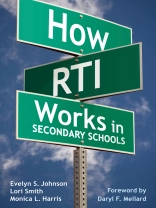‘This book not only provides a solid foundation for guiding school improvement, but also details an array of very practical tools that can be used to implement tiered instructional options in middle and high school settings.’
—Donald D. Deshler, Williamson Family Distinguished Professor of Special Education
Director, Center for Research on Learning
University of Kansas
‘From research-based screenings to evidence-based interventions, the authors address the challenges specific to secondary schools and provide concise, realistic options.’
—Nicole Power, RTI Coordinator and Speech Language Pathologist
Bethany Public Schools, OK
Practical solutions for implementing RTI and improving student outcomes in Grades 6–12!
Implementing Response to Intervention (RTI) in Grades 6–12 offers many unique challenges, but this comprehensive, research-based book provides secondary school administrators with the information, resources, and guidance necessary to use RTI for the benefit of struggling adolescent learners.
Drawing on the latest research, the authors identify the current best practices for key components of RTI and demonstrate how school teams can work together to implement an assessment- and data-driven decision-making process for educators. Describing how all these elements can work together under the RTI framework, this book provides:
- Specific guidance on building leadership capacity to make RTI implementation a success
- Case studies that illustrate real middle and high school RTI models
- Instructional strategies for tiers one, two, and three
- Forms, checklists, and lists of Web and print resources
With this valuable resource, secondary school leaders can avoid potential missteps when implementing RTI and make dramatic improvements in outcomes for adolescent learners!
表中的内容
Foreword
Acknowledgments
About the Authors
1. What Is RTI?
Purpose of RTI at the Secondary Level
How RTI Works
How RTI Fits With Other Education Initiatives
Purpose of This Book
How This Book is Organized
Summary
2. Implementation and Continuous Improvement
Overview
What are the Desired Outcomes?
How is RTI Expected to Lead to These Outcomes?
What Must Happen If RTI is to Work as Expected?
What Data Can be Used to Inform Implementation Efforts?
How Do We Develop a System for Analyzing and Evaluating Data?
What Systems are Needed for continuous Improvement of the RTI Process?
Summary
3. Leadership Perspectives on RTI
Overview
What is My Role as Building Leader to Implement RTI?
How Do I Start the Process of Implementation?
What Will the Professional Development Needs Be?
RTI Focuses on Academics: What About Behavior?
What if We Identify too Many Kids in Need of Intervention?
What Resources Will I Need to Provide?
What If I Don′t Get Things Right the First Time?
RTI Implementation in Practice
Summary
4. Universal Screening
Definition: What is Universal Screening?
Why is Accuracy Important?
Purpose of Screening at the Secondary Level
What Data Should Be Collected?
Implementation
Leader Tasks
Universal Screening in Practice
Summary
5. Tier 1 Instruction
Definition: What is Tier 1 Instruction?
Purpose of Tier 1 at the Secondary Level
Implementation
Tier 1 in Practice: Cheyenne Mountain Junior High School
Leader Tasks
Summary
6. Tier 2 and 3 Intervention
Definition: What is Tier 2 and Tier 3 Intervention?
Purpose of Tiers 2 and 3 at the Secondary Level
Implementation
Tier 2 in Practice: Mattawan High School
Tier 3 Implementation
Leader Tasks
Summary
7. Progress Monitoring
Definition: What is Progress Monitoring?
Purpose of Progress Monitoring at the Secondary Level
Implementation
Leader Tasks
Summary
8. Conclusion
How is RTI Expected to Lead to Improved Student Learning?
What is the Role of Leadership for Ensuring Successful RTI Implementation?
Why We are Optimistic About the Future of RTI: Two Case Stories
Summary
Appendix: RTI Implementation Checklist
Resources
References
Index
关于作者
Monica L. Harris is an assistant professor at Grand Valley State University in the College of Education. She began her career in education at the secondary level and has experience teaching adolescents in general and special education settings as well as developing and implementing programs for students who struggle academically or are at risk of school failure. Prior to joining the faculty at GVSU, she received her doctoral degree in special education from the University of Kansas, where her research focused on strategy instruction and adolescent literacy. Harris is part of the Strategic Instruction Model (SIM) Professional Developer’s Network and works with school districts to implement tiered intervention using research-based instructional strategies. Currently, her research interests include developing instructional strategies for use in academically diverse classrooms, teacher preparation, and collaborative teaching models.












